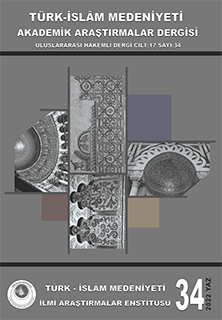Worship in Conservative Judaism
Keywords:
Conservative Judaism, Halacha, Worship, Synagogue, Hebrew, Tradition and ChangeAbstract
As based on Traditional Judaism, Conservative Judaism recognizes that Halacha is regulating the daily life of a Jew and it is binding. Therefore there are three times daily worship and Sabbath worship in Conservative Judaism that are fulfilled regularly. Conservative Judaism sees that Halacha is a part of rituals and since it is in the favor of tradition and changes as a life philosophy, wished that the worship performed in the synagogue would be traditional and suited to the needs of the modern era to attract young American Jews to the synagogue. Thus Conservative Judaism has eased the religious life providing that not to be contradicted Halachaso that the attendants who come to the worship have become more motivated in worship. Some of the examples that show how they eased are; the use of org in the Sabbath worship, allowing women and men to sit together in the same place during worship and giving place to more English translations of Hebrew texts. Such flexible practices have never been practices that have shaken Judaism fundamentally as the Reformists did; considering the local circumstances, only minor changes have been made in accordance with the spirit of time. This understanding is the most characteristic feature of Conservative Judaism, which aims to stick to tradition and change at the same time. In our paper, the subject of worship in Conservative Judaism was discussed in the frame of mentioned above.
References
BESALEL, Y., 2001, “Yahudilik Ansiklopedisi”, İstanbul: Gözlem Gazetecilik Basın ve Yayın A.Ş.
BRAWER, N., 2008, “A Brief Guide to Judaism”, Philadelphia: Running Press.
BRIDGER, D., 1962, “The New Jewish Encyclopedia”, New York: Behrman House.
COHN-SHERBOK, D., 1996, “Modern Judaism”, New York: St. Martin’s Press.
DORFF, E., N., 1996, “Conservative Judaism: Our Ancestors to Our Descendants”, New York: National Youth Commission, United Synagogue of Conservative Judaism.
GILLMAN, N., 1993, “Conservative Judaism: The New Century”, New Jersey: Behrman House, Inc.
GORDIS, R., 1978, “Understanding Conservative Judaism”, New York: The Rabbinical Assembly.
GÜÇ, A., 2011, “Yahudilik: Mabed ve İbadet”, Türkiye Diyanet Vakfı İslâm Ansiklopesdisi (DİA), 43: 207–212.
GÜRKAN, S., L., 2012, “Yahudilik”, İstanbul: İslam Araştırmaları Merkezi (İSAM) Yayınları.
http://www.usy.org/usy2016/wp-content/uploads/2011/07/halacha-map.pdf 9/11/2017
KARESH, S.E.; HURVITZ, M., M., 2006, “Shabbat”, Encyclopedia of Judaism, ed. J. Gordon Melton, New York: Facts On File, Inc., 463-464.
KARESH, S., E.; HURVITZ, M., M., 2006, “Encyclopedia of Judaism”, ed. J. Gordon Melton, New York: Facts On File, Inc.
KATZ, M.; SCHWARTZ, G., 2012, “Shabbat”, The Observant Life. ed. M. S. Cohen, M. Katz, New York: The Rabbinical Assembly, 98-136.
KLEIN, I., 1979, “A Guide to Jewish Religious Practice”, New York: The Jewish Theological Seminary of America.
MEDWED, K., G. Reiss, 2012, “Prayer”, The Observant Life. ed. M. S. Cohen; M. Katz, New York: The Rabbinical Assembly, 5-60.
NADELL, P., S.; RAPHAEL, M. L., 1988, “Conservative Judaism in America”, New York: Greenwood Press.
NORWOOD, S. H.; POLLACK, E., G., 2008, “Encyclopedia of American Jewish History”, California: Santa Barbara, ABC- CLIO.
PRELL, R.,E., 2002, “A New Key: Decorum and the study of Jews and Judaism”, American Jewish History, 90.1, 13-25.
PRELL, R.-E., 1989, “Prayer & Community: The Havurah in American Judaism”, Detroit: Wayne State University Press.
ROSENTHAL, G. S., 1978, “The Many Faces of Judaism”, New Jersey: West Orange, Behrman House, Inc.
ROTHSCHILD, F., A.; MEIR, E., 2007, “Heschel, Abraham Joshua”, EJ, 9, ed. Michael Berenbaum; Fred Skolnik. Detroit: Macmillan Reference, 70-73.
RUBENSTEIN, J., 1991, “Ethics and Liturgy of Conservative Judaism”, Judaism, 40/1, 95-114.
SIEGEL, S., 1977, “Conservative Judaism and Jewish Law”, New York: The Rabbinical Assembly.
Downloads
Published
How to Cite
Issue
Section
License

This work is licensed under a Creative Commons Attribution-NonCommercial 4.0 International License.







